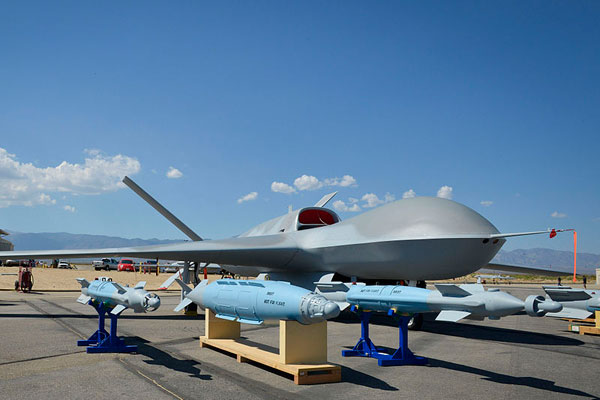The Avenger is a more potent and lethal version of all previous Predator UAVs and should maintain a long and healthy tenure in service to the American Military should her technology live up to her billing. First flight was completed on April 4th, 2009 and the prime contractor is General Atomics Aeronautical Systems of San Diego, California.
The original Predator A (MQ-1) began life as a reconnaissance platform and was only later modified to carry Hellfire anti-tank missiles. The Predator B (MQ-9 "Reaper") was a second generation predator developed from the beginning to carry weaponry but sported improved performance capabilities. The third generation of Predator (Predator C, "Avenger"), is more in line with the current and upcoming crop of 5th Generation fighters being deployed by the USAF.
Working in conjunction, this will put the USAF leaps ahead of any air force in existence. One positive selling point of the new Avenger UAV is its use of existing Predator A and Predator B ground-based infrastructure meaning that the US military would need only to procure the Avenger itself and any new available software to run her as they did with the previous Predator offerings.
Performance specifications include a top speed in excess of 460 miles per hour with an operational ceiling comparable to a military fighter at 60,000 feet. Endurance is listed at 20 hours but this is extendable by way of an optional internal fuel tank taking up space in the bomb bay if need be. The internal fuel tank increases endurance by an additional two hours of flight time.
Externally, the Avenger is of a sleek and ultra-modern design, more akin to perhaps Lockheed's style of designing their new range of stealth aircraft such as the F-22 and F-35. She features the perfect blend of curves coupled with sharp angles to best deflate incoming radar signals meant to track her. The forward portion of the fuselage is devoid of features and appears as a cockpit-less snout. Wings are slightly swept back and fitted along amidships, measuring some 66 feet across. There are no horizontal planes as the Avenger was designed with a "Y" type vertical fin assembly covering the form and function of both vertical and horizontal planes as found on conventional aircraft. There is an identifiable air inlet above the fuselage just behind the center portion of the wings to aspirate the jet engine held within.
The engine exhausts at the rear through a diminutive "S" shaped exhaust duct to help reduce its heat signature. The venting is shielded from the ground by a short-running panel extending passed the actual exhaust port. The Avenger is fitted with the General Atomics-developed "Lynx" Synthetic Aperture Radar (SAR) system as well as the AESA Wide-Area Surveillance Sensor. The former is based on the system that will be incorporated into the Lockheed F-35 Lightning II as part of its Electro-Optical Targeting System (EOTS). She is launched and recovered from conventional runways and makes use of a tricycle undercarriage made up of two main landing gear legs and a nose landing gear leg.
The Avenger makes use of an internal bomb bay to help keep its radar signature to a minimum. She has been cleared to carry the AGM-114 Hellfire anti-tank missile system (common to the Hughes AH-64 Apache attack helicopter), the GBU-24 Paveway III laser-guided bomb, the GBU-31 JDAM (Joint Direct Attack Munition) turning conventional drop bombs into guided threats, and GBU-38 Small Diameter Bombs, bombs designed to improve ordnance carrying capabilities of a given aircraft. Payload is limited to 3,000lbs of internal ordnance. Weapons in the internal bay can be substituted with sensor, electronic and radar equipment as needed.
With the listed performance specifications and capabilities, the Avenger could very well prove to be a potent weapon system for the near future - that is until the enemy developed UAV hunters to cancel out any gains of such combat UAVs as the Avenger. Until then, more human-piloted robots will continue to grace the skies of modern battlefields. To date, pictures of the Avenger have showcased her with a two-tone grey camouflage paint scheme. Of note during testing was the Avenger's use of a tailhook, perhaps meaning that the Avenger will be evaluated for onboard ship launching/recovery or simply indicating that the UAV will rely on the tailhook to shorten her runway landings.
The Avenger is fully-capable of tackling both combat and reconnaissance-oriented missions, limited only by mission role and payload carried.
Technical Specifications:
General Atomics Avenger (Predator C)
Country of Origin:
United States
Manufacturer:
General Atomics Aeronautical Systems - USA
Initial Year of Service:
2015
Production Total:
4
Crew:
3
Length:
41.01 ft (12.5 m)
Width:
66.01 ft (20.12 m)
Height:
0.00ft (0.00 m)
Weight (Empty):
0 lb (0 kg)
Weight (MTOW):
0 lb (0 kg)
Wingspan:
66 ft (20 m) sweep angle 17°
Max takeoff weight:
18,200 lb (8,255 kg)
Fuel capacity: 7,900 pounds (3,600 kg)
Powerplant:
1 x Pratt & Whitney Canada PW545B turbofan engine developing 4,119 lb of thrust
Maximum Speed:
463 mph (745 kmh; 402 kts)
Maximum Range:
0 miles (0 km)
Cruise speed:
402 mph (349 kn; 647 km/h)
Endurance:
18 hours
Service Ceiling:
60,000 ft (18,288 m; 11.4 miles)
Rate-of-Climb:
0 feet-per-minute (0 m/min)
Armament:
Internal weapons bay with 3,500 pounds (1,600 kg) capacity. 6 external hardpoints. 6,500 pounds (2,900 kg) payload total.
AGM-114 Hellfire anti-tank missile
GBU-39 SDB - 250 lb bombs
GBU-24 Paveway III guided bomb
GBU-31 JDAM guided bomb
GBU-38 Small Diameter bomb
GBU-16 Paveway II
GBU-32 JDAM - 1000 lb bombs
HELLADS 150 kW directed energy weapon
Fuel Tank adding 2 hours of endurance
Avionics:
Lynx Synthetic Aperture Radar
AESA Wide-area surveillance sensor


No comments:
Post a Comment